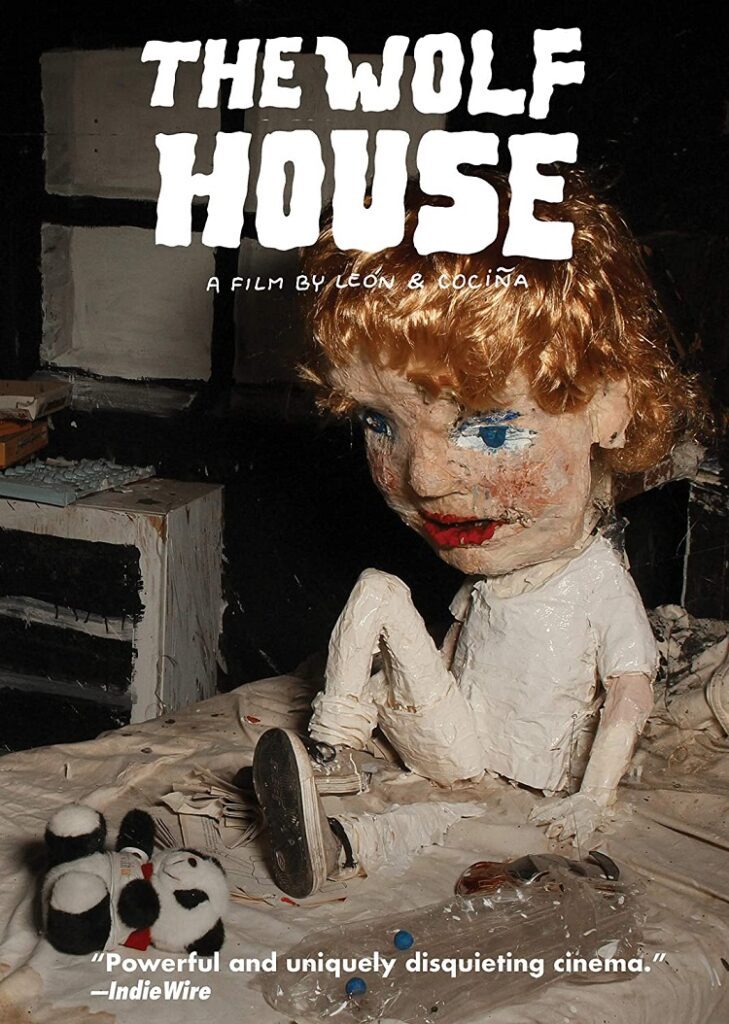
Written by Ram Venkat Srikar
The Wolf House is 73 minutes of “Wow! How did they pull off?” The startling stop-motion animation, which bestows ‘awe!’ after ‘awe!’ every minute is only one of the pillars that hold this astonishing form of story-telling. Masquerading as a propaganda film to cleanse the ill-reputation of Colonia Dignidad, an isolated community formed by German fugitive Paul Schäfer, there’s more to the film than what appears, although it draws little from the real-life incidents, on the surface. The community, which was legally bound for agriculture activities, became infamous for the torture, internment, and murders that came to light a few years later.
A male voice (could be a portrayal of Schäfer) at the beginning of the film that the growing negative perception towards the community is mainly attributed to ignorance and the restored film that follows is intended to shed light on how peacefully the community is thriving. The voice also extends gratefulness to filmmakers Joaquin Cociña and Cristóbal León. It’s evident that the film’s being a satire, while also reminding us there have been instances when (propaganda) films forefronted political motives. The Wolf House, though, admonishes us to look at the irony, which is the focal point of the narrative.
The Wolf House is the film-inside-film, that is followed by the aforementioned introduction by the male voice. The fact that what we see is a masqueraded propaganda film, re-shapes the way we would have perceived it otherwise. The three-minute introduction is equally crucial as the entire film that succeeds it, to discern the aesthetic sense of the story-telling. The classic use of text introduces the plot of Maria, a young girl from Colonia Dignidad, who escaped into the forest surrounding it after being punished for letting three pigs escape. As Maria forays into the forest, alone, traumatized by the fear of wolves, she finds shelter in an abandoned house amid dense woods. The use of stop-motion animation expands the set rules of assembling and pulling off a scene. We see the house from Maria’s viewpoint, during her first encounter with it. Even Maria is never completely represented in human form. She is a painting on the wall that melts into liquid before taking her cardboard form, which persists for the majority of the film. The endless metamorphosis in shapes and forms is a reflection of a child’s imagination or a lack of true identity.
The props, let it be a bowl on a dining table, a clock on the wall, or a wall-mounted painting, are relentlessly shifting positions, representing the passage of time in her mind, and the sense of inconsistency inside the protagonist. Maria is later joined by the pigs, whose freedom was bestowed by her, and she sees them grow into human children. She becomes their mother, taking care of them, reading them stories, and setting rules to never venture into the forest. The setting of the film, which mirrors a haunted house of the most poetic form, finds relevance in these times of isolation.
Although Maria physically isolates herself, the wolf (or I may say, Schäfer) continues to taunt her. Let it be scary episodes that take us through Colonia Dignidad, accompanied by Schäfer’s voice, or the sound of breathing around her, she consistently feels and fears his presence. The man is given the form of a wolf in her imagination to keep her children – whom she names Anna and Pedro – from stepping out of the house. The upbringing too, is converse to her’s. She is never angry or physically abusive, although a certain level of imposition is visible. It’s a glimpse of what kind of person Maria could be if she has children. The Wolf House answers the question, “how will a girl with a traumatizing childhood evolve into a mother?” with beautiful imagery complemented by the child’s innocence, while a dark shadow from the past continually instills fear.
Although the film reasons the fear of punishment instigated Maria to run away, it has to be noted that Paul Schäfer is a convicted pedophile. Little too dark for an animated movie, ain’t it? The Wolf House could be one of the darkest animated films ever, where the horror and fear are as much in the mind, as much it is in the creepy isolated house in the forest.
Every single frame of The Wolf House is suffused with artistic beauty that it is impossible to note the painstaking labor that must have gone to create thousands of frames. If the breath-taking animation that pushes the boundaries of story-telling doesn’t win you over, the shocking nature, which is certainly not a trait often associated with animated films, will impact you more than you expect.
If Florian Gallenberger’s Colonia portrayed the horror from the inside of Colonia Dignidad, relying on physical violence, The Wolf House marries the subject matter with a child’s imagination, and the result is an experience that is equally appalling and exquisite.